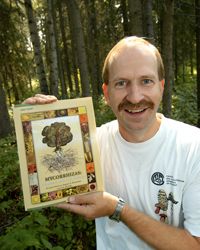NEW BOOK EXPLORES VITAL RELATIONSHIP FOR PLANT SURVIVAL
September 13, 2004 for immediate release

AUNBC professor is one of the authors of a comprehensive new book thatexamines the close relationship between plant root cells and fungi thatare critical to plant growth and survival.
This relationship is called a mycorrhizal association and is thesubject of "Mycorrrhizas: Anatomy and Cell Biology" published by theNational Research Council of Canada. Forestry professor Dr HuguesMassicotte was one of the book's authors, along with Dr Larry Petersonand Lewis Melville, both of the University of Guelph. Their group hasbeen amongst the world's leading teams examining the structuraldiversity of root-fungal associations and the book has been describedas "the culmination of a lifetime of research." It is one of the mostcomprehensive collections on the structure of mycorrhizas to bepublished to date.
"The majority of plants on earth rely on symbiotic associations withfungi to absorb nutrients, fend of diseases, tolerate droughtconditions, and even protect themselves against some toxic metals inthe soil," says Dr Massicotte. "Understanding this relationship iscritical to addressing problems in agriculture, forestry, andenvironmental restoration. For example, researchers from UNBC andUBC-Okanagan are conducting one of the first studies on the effects ofthe BC wildfires last summer, examining the role of mycorrhizal fungias forests regenerate."
Among the 300 images that appear in the book, several originated fromvarious locations around Prince George, including the UNBC campus,Forests for the World, Willow River, Ness Lake, Bednesti, and BearLake. While not all fungi have a mycorrhizal relationship, manyfamiliar mushroom species in the Boletes and Chanterelles do have asymbiotic relationship with plants.